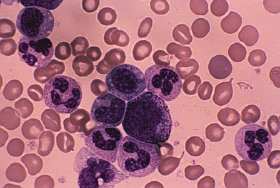Chronic Myeloid Leukemia (CML)
 |
| The white blood cell count is high and cluster together in the peripheral blood. Some of the granulocytes are dysplastic with abnormal lobulation of the nuclei. |
|
Chronic myeloid leukemia is a myeloproliferative disorder caused by the transformation of a single hematopoietic stem cell. More than 95% of
CML patients present an abnormal chromosome 22 named Philadelphia chromosome
(Ph chromosome) that is the result of a translocation
between chromosome 9 and chromosome 22. The ensuing gene formed
by the translocation encodes protein with a deregulated activity (oncogenic)
that leads to proliferation of mature as well as less mature progenitor
cells.
CML has an incidence of 1 to 2 cases per 100 000 people per year and accounts
for 15 % of the leukemia's in adults. The median age of patients at presentation
is 45 to 55 years.
Treatment
During the chronic phase of CML, cytoreductive therapy with hydroxyurea
or busulfan usually induces hematological remissions. In addition, interferon
alpha has been used to control CML. Recently, imatinib (Glivec®) has
been shown to induce complete hematological responses in most patients.
However, all these treatments are palliative and do not cure CML. Only
an allogeneic HSCT is able to cure CML.
|



 Print
Print